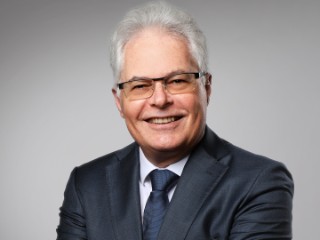Prof. Weidner, what does the bioeconomy mean to you?
At Fraunhofer UMSICHT, we focus on three aspects of the bioeconomy: nutrition, agriculture and chemicals. Generally speaking, the bioeconomy encompasses a variety of sectors that are all interconnected. It requires knowledge about these sectors as well as how they interact. For example, chemicals can lead to biofuels and thus overlap with mobility, but also provide sustainable base materials for use in chemistry.
We at Fraunhofer UMSICHT not only address technical questions, but also think about, for example, how best to use the surface of our planet. It goes without saying that food comes first, but even that poses a challenge when it comes to feed for livestock holdings, which currently account for 58 percent of land use. Is that tenable? What could sustainable use of georesources look like? We need to address this question, so we won’t need two or three planets in the future, but can get by with the one we have.
What role, would you say, Fraunhofer UMSICHT plays in the bioeconomy?
We view ourselves as a pioneer for a sustainable world. While we come from the experimental and technological side of things, we also provide services. For example, we combine life cycle analysis with social components. Our approach is highly participatory, meaning we take into account actors along the value chain, including politics and society.
What exactly does research look like at Fraunhofer UMSICHT, for example in the bioeconomic area of agriculture?
We as a society now use water treatment plants to eliminate waste. We won’t be able to afford to do that in the future, as we lose many valuable nutrients such as phosphorous that way. The goal needs to be to recover nutrients within a closed circuit. We’re examining what that could like in the NewTrient project: we recover nutrients from a water treatment plant and use them as fertilizer in a greenhouse.
Speaking of agriculture, how do you cultivate the necessary food at a location closer to the people? That’s why we established the ALTMARKTgarten greenhouse on the roof of the Oberhausen job center and opened it one year ago. The building’s energy and water supply is coupled with that of the garden. This rooftop greenhouse has captured plenty of attention throughout Germany.
A sustainable economy also encompasses sustainable mobility. How can the bioeconomy help?
It can do a great deal. For example, we’re working on producing fuels out of biological and other residues that otherwise cannot be used. We’re also pursuing two technologies: First of all, we ferment agricultural waste and turn it into ethanol, from which we produce fuels that can be used in conventional engines. In this way, we can reduce the carbon footprint by 20 to 30 percent and lower emission from 90 grams per kilometer to around 60 grams per kilometer. The second approach is pyrolysis with subsequent hydrogenation, which we can use to turn residues such as sewage sludge or fermentation residues from biogas plants into a refinery-compatible substitute for fossil fuels.
This is attractive for the aviation industry in particular, which has committed itself to ensuring that alternative raw materials account for 10 percent of the kerosene it uses in Germany by 2025. UMSICHT Sulzbach-Rosenberg employees are core partners in an EU project dedicated to producing 1000 to 1200 metric tons of a fuel like this over the next two years.
What else can the bioeconomy do?
The bioeconomy can also do a great deal in the field of biopolymers. We develop biopolymers for a whole host of applications. In Italy, for example, all of the plastic bags have to be made from biodegradable plastic. Developing formulas for requirements like these is one of our core areas of expertise. We’re also active in geotextiles. For example, we develop biodegradable polymer films for a variety of applications, including embankment stabilization. These films anchor young plants as they grow. Unlike conventional films, these innovative films decompose into carbon dioxide and water after a certain period of time, once the plants have had the opportunity to form sufficient roots and runners. We’re currently conducting field tests.
